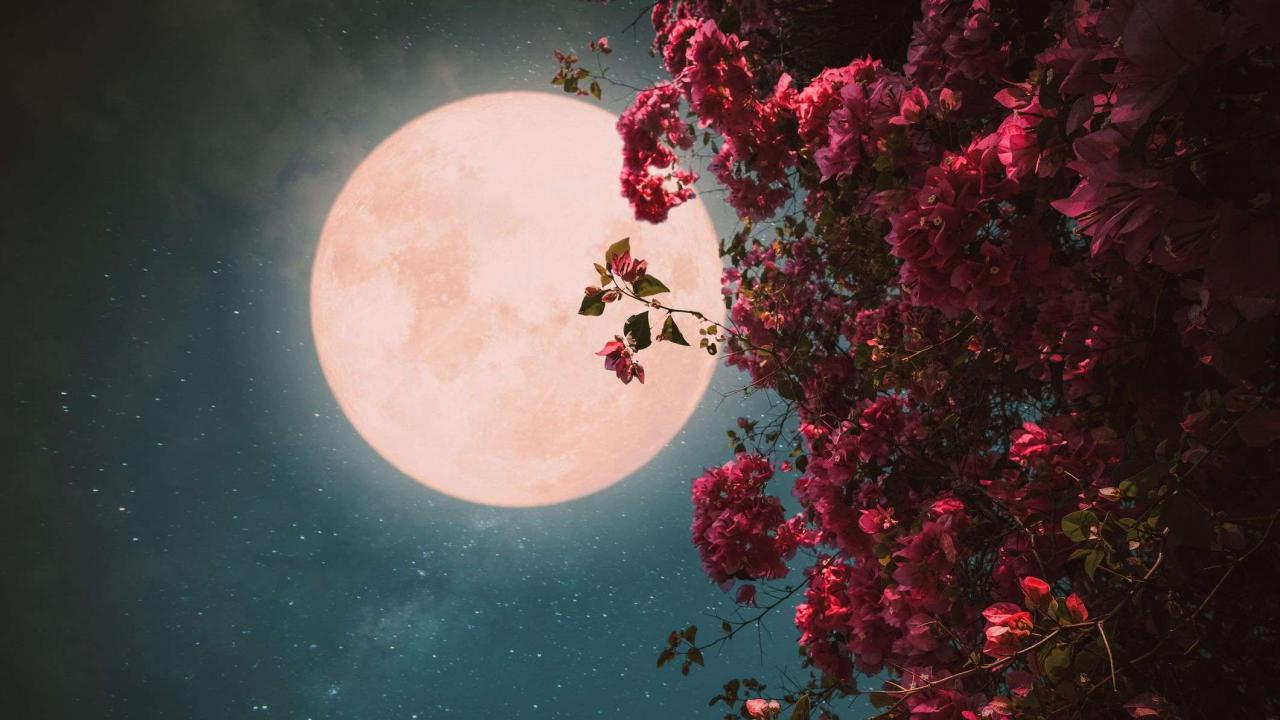
The Pink Moon 2024, an astronomical event that will grace the night sky, is set to captivate stargazers and nature enthusiasts alike. This celestial phenomenon holds significant cultural, historical, and scientific implications, making it a spectacle not to be missed.
As the moon reaches its peak illumination, it will adorn a captivating pink hue, a result of the Earth’s atmospheric scattering of sunlight. This celestial event has been observed and celebrated by various cultures throughout history, with unique folklore and traditions associated with it.
Pink Moon 2024: A Celestial Spectacle
The Pink Moon, a captivating astronomical event, is set to grace the night sky in 2024. This full moon holds significance not only in the celestial realm but also in cultural traditions and scientific research. As we anticipate this celestial spectacle, let’s delve into its astronomical, cultural, and scientific implications.
Astronomical Significance of the Pink Moon 2024

The Pink Moon refers to the first full moon that appears after the Spring Equinox in the Northern Hemisphere. This year, it is expected to occur on April 19, 2024. The term “Pink Moon” is not related to the color of the moon, which typically appears white or slightly yellowish.
Instead, it is derived from the Native American tradition of naming the full moons based on seasonal events. In April, the blooming of wildflowers, particularly pink phlox, inspired the name “Pink Moon.”Astronomically, the Pink Moon is a time of heightened lunar activity.
The moon’s gravitational pull exerts a stronger influence on Earth’s tides, leading to higher high tides and lower low tides. Additionally, the moon’s position in the sky during this time creates favorable conditions for stargazing, as the Milky Way is more visible due to the absence of moonlight.
Cultural and Historical Context of the Pink Moon, Pink moon 2024
The Pink Moon has held cultural significance across different regions and time periods. In Native American traditions, it marked the beginning of the planting season and was associated with fertility and new life. In European folklore, the Pink Moon was believed to bring good luck and prosperity.
It was also associated with the celebration of Easter, which typically falls around the time of the Pink Moon.In modern times, the Pink Moon continues to inspire cultural expressions. Artists and photographers capture its ethereal beauty in their works, while writers and poets draw inspiration from its symbolism.
The Pink Moon has become a symbol of hope, renewal, and the promise of spring.
Impact on Wildlife and Natural Phenomena
The Pink Moon’s gravitational pull and increased moonlight can influence the behavior of wildlife. Some species, such as wolves and owls, are known to become more active during this time. The higher tides associated with the Pink Moon can also affect the feeding and breeding patterns of marine life.In
ecosystems, the Pink Moon’s light can disrupt the nocturnal activities of certain animals. For example, some nocturnal insects may reduce their activity levels due to the increased moonlight. This, in turn, can impact the feeding behavior of animals that rely on these insects for sustenance.
Visual Representation and Artistic Inspiration
The Pink Moon’s captivating appearance has inspired countless works of art throughout history. Photographers have captured its ethereal glow and soft hues, while painters have used it as a subject for landscapes and still lifes. The Pink Moon has also been immortalized in sculptures, mosaics, and other art forms.The
unique beauty of the Pink Moon has served as a muse for artists, who find inspiration in its symbolism and visual appeal. Its depiction in art reflects the cultural and emotional significance that the Pink Moon holds for humanity.
Scientific Research and Exploration
The Pink Moon presents an opportunity for scientific research and exploration. Scientists use this event to study the moon’s surface, atmosphere, and gravitational effects. Telescopic observations and data collection during the Pink Moon help researchers gain insights into lunar phenomena and the dynamics of the Earth-Moon system.Ongoing
missions, such as the Lunar Reconnaissance Orbiter, provide valuable data about the Pink Moon’s characteristics. Future missions may aim to explore the moon’s surface during this time, offering a unique opportunity to study the lunar environment under specific lighting conditions.
Final Summary

The Pink Moon 2024 serves as a reminder of the intricate connection between humanity and the cosmos. Its astronomical significance, cultural impact, and potential influence on wildlife make it a fascinating subject for exploration and appreciation. Whether you choose to marvel at its beauty through stargazing or delve into its scientific intricacies, this celestial event promises an enriching experience.
Popular Questions
What is the scientific reason behind the Pink Moon’s hue?
The Pink Moon’s pinkish appearance is an optical illusion caused by the scattering of sunlight by particles in the Earth’s atmosphere.
What is the cultural significance of the Pink Moon?
In many cultures, the Pink Moon is associated with fertility, new beginnings, and spiritual renewal.
Can the Pink Moon affect animal behavior?
The Pink Moon’s gravitational pull and increased light can influence animal activities such as mating, hunting, and migration.





